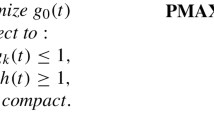Abstract
Recently, various interior point algorithms related to the Karmarkar algorithm have been developed for linear programming. In this paper, we first show how this “interior point” philosophy can be adapted to the linear ℓ1 problem (in which there are no feasibility constraints) to yield a globally and linearly convergent algorithm. We then show that the linear algorithm can be modified to provide aglobally and ultimatelyquadratically convergent algorithm. This modified algorithm appears to be significantly more efficient in practise than a more straightforward interior point approach via a linear programming formulation: we present numerical results to support this claim.
Similar content being viewed by others
References
E. Barnes, “A variation on Karmarkar's algorithm for solving linear programming problems,”Mathematical Programming 36 (1986) 174–182.
I. Barrodale and F. Roberts, “An improved algorithm for discrete ℓ1 linear approximation,”SIAM Journal on Numerical Analysis 10 (1972 839–848.
R.H. Bartels, A.R. Conn and J.W. Sinclair, “Minimization techniques for piecewise differentiable functions: the ℓ1 solution to an overdetermined linear system,”SIAM Journal Numerical Analysis 15 (1978) 224–240.
C. Bischof, “QR factorization algorithms for coarse-grained distributed systems,” Technical Report 88-939, Cornell University (Ithaca, NY, 1988).
T.F. Coleman and P. Plassmann, “Solution of nonlinear least-squares problems on a multiprocessor,” in: G. van Zee and J. van de Vorst, eds.,Parallel Computing 1988, Shell Conference Proceedings, Lecture Notes in Computer Science No. 384 (Springer, Berlin, 1989).
T.F. Coleman and A. Pothen, “The null space problem I: Complexity,”SIAM Journal on Algebraic and Discrete Methods 7 (1987) 527–537.
T.F. Coleman and A. Pothen, “The null space problem II: Algorithms,”SIAM Journal on Algebraic and Discrete Methods 8 (1987) 544–563.
J.E. Dennis, Jr. and J.J. Moré, “Quasi-Newton methods, motivation and theory,”SIAM Review 19 (1977) 46–89.
I. Dikin, “Iterative solution of problems of linear and quadratic programming,”Doklady Akademiia Nauk SSSR 174 (1967) 747–748.
P. Gill, W. Murray, M. Saunders, J. Tomlin and M. Wright, “On projected Newton barrier methods for linear programming and an equivalence to Karmarkar's projective method,”Mathematical Programming 36 (1986) 183–209.
N. Karmarkar, “A new polynomial-time algorithm for linear programming,”Combinatorica 4 (1984) 373–395.
M.S. Meketon, “Least absolute value regression,” Technical Report, AT&T Bell Laboratory (Murray Hill, NJ, 1987).
C.B. Moler, J. Little, S. Bangert and S. Kleiman,ProMatlab User's Guide (MathWorks, Sherborn, MA, 1987).
J.M. Ortega and W.C. Rheinboldt,Iterative Solution of Nonlinear Equations in Several Variables (Academic Press, New York, 1970).
M.R. Osborne,Finite Algorithms in Optimization and Data Analysis (Wiley, New York, 1985).
J. Renegar, “A polynomial-time algorithm, based on Newton's method, for linear programming,”Mathematical Programming 40 (1988) 59–93.
S.A. Ruzinsky and E.T. Olsen, “ℓ1 and ℓ∞ minimization via a variant of Karmarkar's algorithm,”IEEE Transactions on Acoustics Speech and Signal Processing 37 (1989) 245–253.
E. Seneta and W.L. Steiger, “A new lad curve-fitting algorithm: Slightly overdetermined equation systems in ℓ1,”Discrete Applied Mathematics 7 (1984) 79–91.
M. Todd, “Polynomial algorithms for linear programming,” in: H. Eiselt and G. Pederzoli, eds.,Advances in Optimization and Control (Springer, Berlin, 1988) pp. 49–66.
C. Van Loan, “On the method of weighting for equality-constrained least squares problems,”SIAM Journal on Numerical Analysis 22 (1985) 851–864.
R.J. Vanderbei, M.S. Meketon and B.A. Freedman, “A modification of Karmarkar's linear programming algorithm,”Algorithmica 1 (1986) 395–407.
Author information
Authors and Affiliations
Additional information
Research partially supported by the Applied Mathematical Sciences Research Program (KC-04-02) of the Office of Energy Research of the U.S. Department of Energy under grant DE-FG02-86ER25013.A000, by the U.S. Army Research Office through the Mathematical Sciences Institute, Cornell University, and by the Computational Mathematics Program of the National Science Foundation under grant DMS-8706133.
Research partially supported by the U.S. Army Research Office through the Mathematical Sciences Institute, Cornell University and by the Computational Mathematics Program of the National Science Foundation under grant DMS-8706133.
Rights and permissions
About this article
Cite this article
Coleman, T.F., Li, Y. A globally and quadratically convergent affine scaling method for linearℓ 1 problems. Mathematical Programming 56, 189–222 (1992). https://doi.org/10.1007/BF01580899
Received:
Revised:
Issue Date:
DOI: https://doi.org/10.1007/BF01580899



